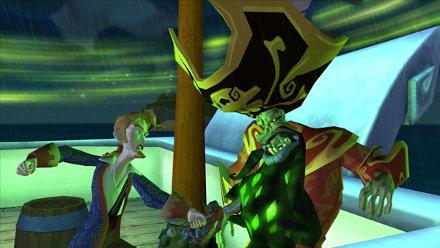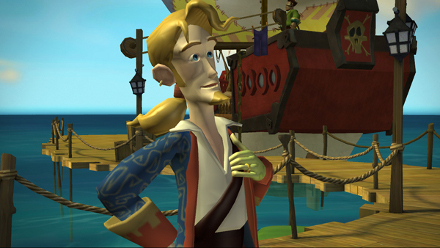Reviews
Review: Tales of Monkey Island
July 5, 2010, Author: Andy Corrigan
Shamefully, I’ve never really experienced the adventures of Guybrush Threepwood until now. If you’d have uttered that name in my direction few years back and I’d have probably thought that you were talking about a sexually transmitted infection. That’s not to say that I don’t understand that the original Monkey Island games have legendary status in the industry; even without playing it, it’s one of the first games that came to mind when thinking about the point and click genre. The series has seen four full games, with the fifth being released episodically on PC last year, and eventually released on PS3 in June just gone.
So when presented with the option to review the series’ first foray into the world of episodic gaming, I have to admit that initially I was wavering slightly. Think about it; I would be coming into a series with established characters, concepts and inside jokes, and please make no mistake; that is a daunting task. I’ve seen people do it before on other sites with an unpleasant effect; I could upset generations of devoted followers by not ‘getting’ the series, or even by praising a title that peaked back in the day and has alienated since fans. Remembering that I’d purchased the Secret of Monkey Island Special Edition on XBLA last year but never finished it, I even rushed through it over the last week to familiarise myself a little more with the characters and the oddball humour before jumping in with both feet. Consummate professional, me.
So with my research completed, I weighed anchor, hoisted the mizzen mast, shivered my, erm… timbers (?!) as I set sale to catch up with Guybrush and company.
Please note: Rather than review each episode individually as we would usually do with episodic games, I’ve decided to review the series as a whole. The main reason is that the full series has been available on PC for some time, and is readily available in a bundle, where as the PS3 version is only available as a bundle.
So, who the hell are you people?
For those like me who may never have sampled a Monkey Island title before, we’re a few years into the pirating career of one absurdly named Guybrush Threepwood, now married to the love interest from the original title, Elaine Marley. The story kicks off in the midst of action. Regular villain LeChuck has kidnapped Elaine on her own boat with the intent of stealing her affections, and for some reason is currently torturing the last of thirteen monkeys. Guybrush is apparently thought to have been left for dead, yet in reality his ship is in hot pursuit and he is armed with his cutlass that he needs to spray with Voodoo root beer to dispose of LeChuck.
Before he has chance to lace his sword with the real deal, Guybrush’s typical clumsy nature means he has to concoct a new batch on the fly, which has an adverse effect for all parties. After running LeChuck through with his blade, instead of evaporating as expected, the ghostly enemy oddly becomes human. That’s not all, Guybrush’s left hand becomes infected with the ‘Pox of LeChuck’, leaving him unable control it. In the confusion some gunpowder is set off and the ship explodes, leaving a pox-ridden cloud loose in the world, while Threepwood washed up on the shore of Flotsam Island, where he must meet the locals and try to gain a ship to rescue his long suffering wife. This is as far as I’m willing to go on the story for the series, as the way it unfolds is one of the biggest joys anyone will get from playing the title for themselves.
The story in any episodic series is always going to be the key aspect that keeps people playing, and it pleases me to say that throughout the entire series the story is wittily written, snappy and at times, very funny. The humour can be something of an acquired taste, with a fair amount of the jokes revolving around the groan-worthiest puns and the worst one-liners possible. We’re talking jokes that are so bad that they’re hilarious, and people without a sense of irony should probably give this a wide berth. There are a lot of references to previous games here, as early as the get-go too, and in this respect it did pay off to some degree that I had played through the original game beforehand.
Yet, people who haven’t followed the series should be able to fit in effortlessly. It is completely possible to come into this and warm to the characters immediately, such is the strength of their personalities, and any inside jokes that might go over peoples heads will just fit in with some of the silliness that the series is famed for. That’s not to say that the game is one long joke, there are some truly touching and saddening moments, which not only made me reflect a little, but also gave me memories to some of the classic animated feature films back in the day.
Without saying too much more, predictably, Telltale have made the smart move to end the various episodes on cliffhangers and like with any decent form of episodic entertainment, it’s done in a way that hits the right note and leaves you unable to wait for the next episode. This was terrible for me with all the episodes at my disposal, I can’t even imagine how it must have been absolute torture to wait an entire month.

Enemies to the death...
More control than just pointing and clicking.
As I’m reviewing the PSN version, I somewhat expected that the game would control similarly to the remake of the original, and I couldn’t have been further from the reality. Unlike the original, the game is set in a relatively 3D world (although in some areas you’re left with 2D restrictions), and rather than moving Guybrush around with a cursor, his movement is mapped to the left analog stick. Any items of interest are highlighted when you approach them with a prompt for the X button. The PC version actually uses a combination of the two systems (it even gives you a choice to play more traditionally); the default controls sees you using the WASD keys to move around, and leaving the mouse free to click on anything that looks interesting.
Initially on the PS3 version, this is can be a bit clumsy and it isn’t helped by the fact that the engine is rather fussy about what object it deems that you’re looking at. If, for example, in the opening sequence you are looking at a barrel of grog while stood still, you’ll find the prompt flickering quickly between that and the gunpowder barrels. This can be made worse when the boat moves up and down with the motion of the sea, often changing what you are looking at just as you’re pressing the button. Thankfully, Telltale have accounted for this with a simple but very effective system. Tapping L1 or R1 allows you scroll back and forth through the points and areas of interest on screen, highlighting them with a red cursor and thankfully, overriding the game’s idea of what it thinks you’re looking at. Should you get stuck at any point too, you can always hold either L2 or R2 and all points of interest on screen will be highlighted, giving you a good indication of what you need to be interacting with to progress.
Of course, any adventure game worth its salt requires clever use of the various items that you might pick up along the way, and the inventory system and how you use items are streamlined somewhat here. To use items you simply open the menu using the triangle button, press X on the item you want to use, and then you press X again on the object or person you want it to interact with. As you would expect in a game like this, you will be required to cleverly combine items. On the PC version, your inventory is managed slightly more traditionally, dragging items you need to combine into two dedicated areas and pressing the combine button. On the PS3 it’s even simpler. Open your inventory, press triangle on an item you want to combine, and press triangle once more on the item you want to combine it with.
Some adventure games of this type do have the habit of employing some strange logic when it comes to using items, which would often lead to players wandering around the world using every item on everything just to try and progress. There aren’t that many moments like that in TOMI, with that sort of gameplay left to desperate moments when you’ve missed something so glaringly obvious that you’ll feel like a moron when you realise what you need to do.

Guybrush Threepwood... Mighty Pirate! (TM)
You won’t need an eyepatch.
As I mentioned above, Tales of Monkey Island is a 3D point and click adventure, just like Telltale’s work with Sam & Max. At first the game might seem a little rough around the edges, but this is a port of a PC game, one with a low polygon count, designed run on as many PC’s as possible. That’s not to say that the game is ugly; it’s far from it. The game has a lovely cartoon styling with the cast all brilliantly realised and brimming with character. The environments are also lovingly designed, detailed and full of life. Even better is the variety you’ll encounter over the course of the series, and although you will retread some of the same locations along the way (Flotsom Island being a particular fixture) they always seem fresh and interesting.
Arrrrgh me hearties!
It’s hard to pick just one of my favourite things about my time with TOMI, but the soundtrack is definitely up there. While it features the classic light and breezy Caribbean soundtrack of yesteryear, it’s the darker tones along the way that managed to seduce my aural senses. The scores really hit the spot, some even reminding me of Final Fantasy VII’s most sombre moments, all while pulling the right emotional strings given the situation.
If you think I couldn’t give more praise to Telltale’s sound department, you’re very much mistaken. The voice acting in this game is nigh on faultless. Key players like Dominic Armato and Alexandra Boyd return to voice our premier couple, while the newcomers fit in perfectly. It’s true, the voice actors are helped no end by a witty and flowing script, but their performances are vital to the character’s portraying their personalities. Heritage aside, it’s those personalities that make this game stand out more than than the others in Telltale’s back catalogue
Mighty Game (TM)
Whether you’re a fan of the series or a total newcomer, Tales of Monkey Island will more than likely win you over immediately with a complete charm offensive thanks to likeable characters, clever scripting and high production values. With those three strengths woven into a fabric of classic gameplay, it’s an example of something that has become all too rare in the gaming industry. More importantly, as a first step into the unknown for the Monkey Island franchise and given its status, it’s a pleasure to say that it lends itself perfectly to the episodic structure and suffers none in the transition. At a measly price of £14 on PSN for the series bundle for far more than your monies worth of entertainment, it’s an easy recommendation.
Platforms: PC, PS3 | Tagged Guybrush Threepwood, Monkey Island, Tales of Monkey Island, Telltale Games



